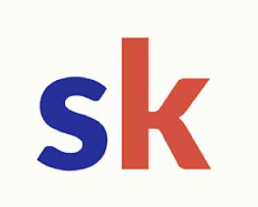
Skool: Your Community, Courses, and Cashflow in One Place
You want one home where people hang out, learn, and buy without juggling five tools. Skool gives you a clean feed, a simple classroom, and an easy calendar that actually gets used. You set the price once and let payouts run while you focus on helping people. It feels calm, organized, and built for momentum.
Friend to friend: a few links are affiliate links. When you purchase, I might get a tiny thank-you from the company, with zero added cost to you. I only recommend things that I’ve actually tried and looked into. Nothing here is financial advice; it is for entertainment. Read the full affiliate disclosure and privacy policy.
You want the fast version: what Skool does, who should use it, and what you’ll net after fees. Connect payouts, pick a price, and launch this weekend. The guide shows $9, $49, and $999 math with a simple 90-day plan.
Skool is a simple hub where your community, courses, and events live together. You choose a plan, set your price, and Skool handles payments and payouts. Hobby is $9/month. Pro is $99/month.
Both include the core features you need and unlimited members and courses. Fees are straightforward and tied to your plan and ticket size, so you can predict margins before you launch.
After you connect your bank through Stripe Express, payouts run on a set schedule, which keeps your bookkeeping clean and your focus on members.
This guide shows the parts that move engagement—points, levels, and leaderboards—then walks through pricing, one-time and subscription options, and practical examples at $9, $49, and $999.

A short launch checklist closes the loop so you can go live with confidence.
Note: pricing and fees can change; verify on Skool’s live pages before purchasing.
What Skool Is and How It Works
One hub for posts, lessons, and events—plus points and levels that keep people coming back.
Skool puts your community, courses, and events in one clean workspace so people join, learn, and keep coming back. Members post in a feed, take lessons in the Classroom, and show up for live sessions on the Calendar.
The system rewards activity with points, levels, and leaderboards to keep momentum high.
Community + Classroom + Calendar
The Community feed is the social heartbeat. Members share posts, comment, and react. Those reactions matter because each like awards a point to the author, feeding the leveling system.
The Classroom organizes lessons, resources, and full courses. Creators can publish courses, set who can access them, and even override access for specific members when needed.
The Calendar hosts your live cadence. You can run webinars or calls and choose who may attend. Event permissions can be open to all, restricted to a level, or tied to course access.
pro_tip: Publish a short “start here” lesson in Classroom and schedule two kickoff events. It gives new members a clear path and fills your first leaderboard quickly.
Points, Levels, and Leaderboards
Skool’s engagement loop is explicit: 1 like = 1 point on posts, comments, or replies. As points accumulate, members level up and appear on the group’s leaderboard.
Levels are local to each group, which lets you design rewards aligned to your community goals. Common rewards include access to private threads, bonus lessons, or level-locked courses.
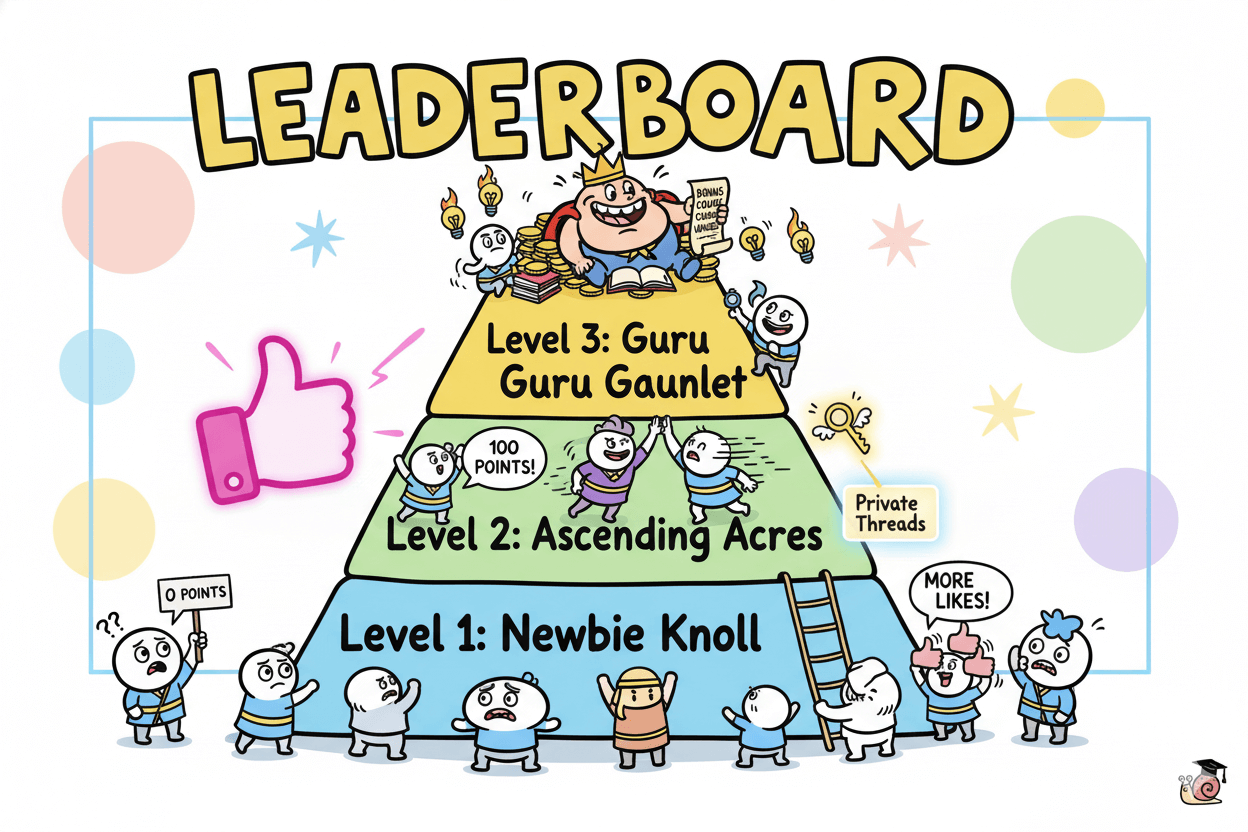
What Members See
Members experience Skool through a simple layout: a home feed for posts, a Classroom tab for lessons, and a Calendar for events.
Their profile displays a level badge, and the leaderboard highlights top contributors—visible progress that encourages daily check-ins. The Skool basics for members guide covers notifications, leveling, and navigation in plain language.
Access and Unlocks: You can lock a course by level, so members unlock content by contributing, not just paying. Events can also be permissioned by level or by course enrollment.
These controls let you create a clear path: participate → level up → unlock valuable rooms.
Plans, Pricing, and Fees Explained
Two plans. Clear fee math. Copy these examples into your sheet.
You only choose once: Hobby or Pro. The features you need are included on both, so the real decision is your margin math. Hobby keeps the monthly bill tiny.
Pro lowers per-transaction fees as you scale. Here’s the clean breakdown, with worked examples you can copy into your spreadsheet.
| Plan | Monthly Price | Admins | Transaction Fees | Included Basics | Free Trial |
|---|---|---|---|---|---|
| Hobby | $9 / month | 1 admin | 10% + $0.30 per transaction | All features; unlimited members; unlimited courses; custom URL; option to hide suggested communities | 14-day free trial |
| Pro | $99 / month | Unlimited admins | 2.9% + $0.30 ≤ $900; 3.9% + $0.30 ≥ $901 | All features; unlimited members; unlimited courses; custom URL; option to hide suggested communities | 14-day free trial |
| Note: Payouts run via Stripe Express. Fees and terms can change—confirm on Skool’s live pages before publishing. | |||||
Hobby vs Pro at a glance
- Hobby — $9/mo: All core features, unlimited members and courses, 1 admin, 10% + $0.30 per sale. Good for testing or small communities.
- Pro — $99/mo: All core features, unlimited members and courses, unlimited admins, lower fees: 2.9% + $0.30 per sale ≤ $900, and 3.9% + $0.30 ≥ $901. Designed for growth.
quick_win: If your monthly revenue target is modest, start on Hobby to validate demand. When your fee line starts to feel heavy, switch to Pro in minutes and widen your margins.
Transaction fees with examples
Use the official fee tiers to model your take-home:
- $9/month offer on Hobby: fee ≈ 10% of 9 ($0.90) + $0.30 = $1.20, net ≈ $7.80. Hobby is efficient for micro-tickets.
- $49/month offer on Pro: fee ≈ 2.9% of 49 ($1.42) + $0.30 = $1.72, net ≈ $47.28. Pro preserves margin on standard memberships.
- $999 program on Pro: fee ≈ 3.9% of 999 ($38.96) + $0.30 ≈ $39.26, net ≈ $959.74. Pro’s higher-ticket tier applies at $901+.
myth_buster: Stripe’s own list price isn’t your baseline inside Skool. The Pro schedule already bakes in typical add-ons like international and subscription surcharges, which is why many switchers see 1–2% savings vs running standalone Stripe. Always confirm on the live FAQ.
Payouts and pricing models
Before you charge, connect your bank using Stripe Express inside Skool. Then set your price and choose a model: Free, Subscription, Freemium, Tiered, or One-time.
You can mix models inside the same group, and later add annual options if you offer them. Payouts typically initiate weekly and land in 2–3 business days in the U.S. (longer internationally).
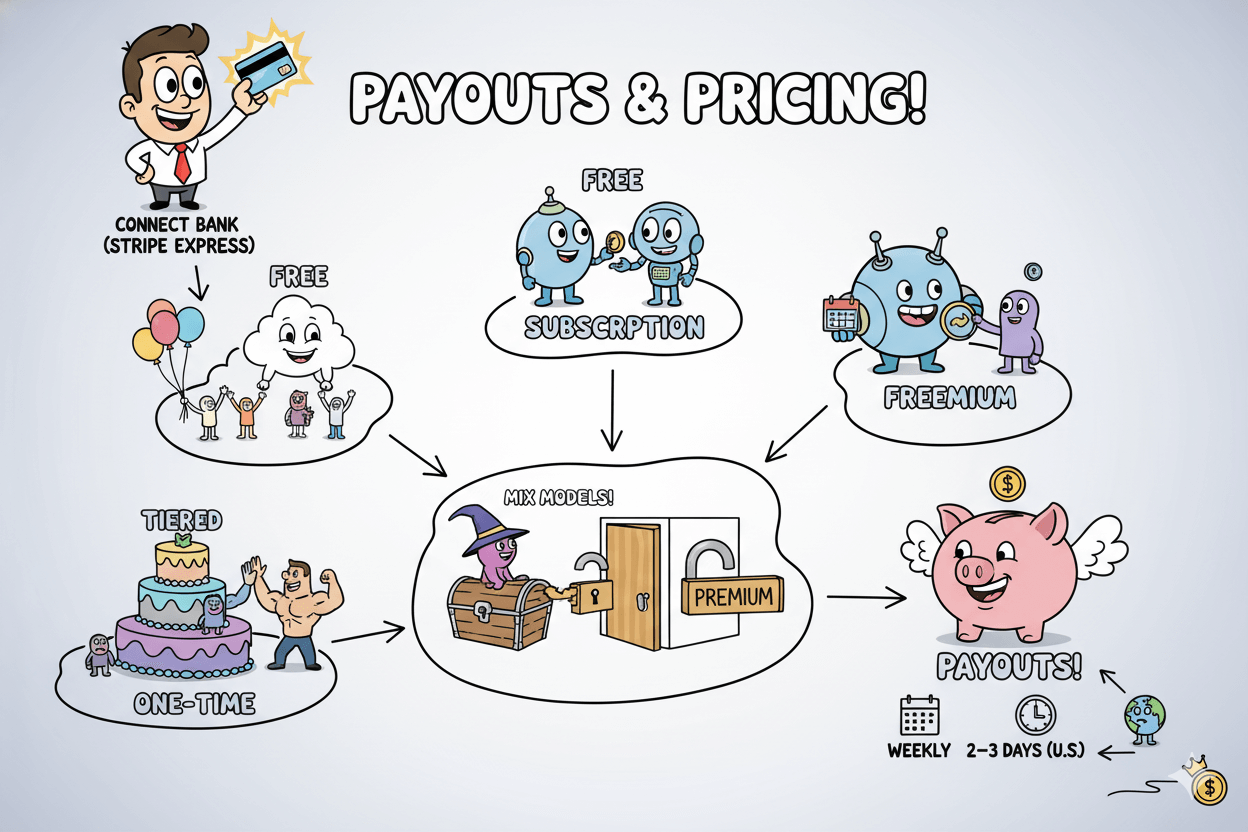
Disclaimer: Pricing and fees can change. Verify the Pricing page and Payments FAQ before publishing or purchasing.
Set Up Your Offer
Free, freemium, tiers, and one-time—mix models without new tools.
Start simple. Pick a pricing model that matches how your audience buys, connect payouts, then publish your first course and event.
Skool lets you run free, freemium, tiered memberships, and one-time course purchases in the same group, so you can test fast and evolve without migrating tools.
Free, Freemium, and Tiered Pricing
Use Free to seed a community and validate demand. Freemium looks free at signup and reveals paid upgrades after members join, which helps conversion by letting value sell itself.
Tiers show multiple paid plans at signup for clear price anchoring. Skool’s pricing settings page explains where to toggle each model.
pro_tip: Start freemium to warm cold traffic, then introduce tiers once you know which benefits members value most.
Subscriptions vs One-Time Course Purchases
Subscriptions create recurring revenue and are set at the group level. For launches, upsells, or premium modules, enable one-time course purchases in the course settings via “Buy Now.”
This lets you sell a fixed-price course alongside a free or paid community without spinning up a second platform. The help guide walks you through setup and links to create/publish lessons first.
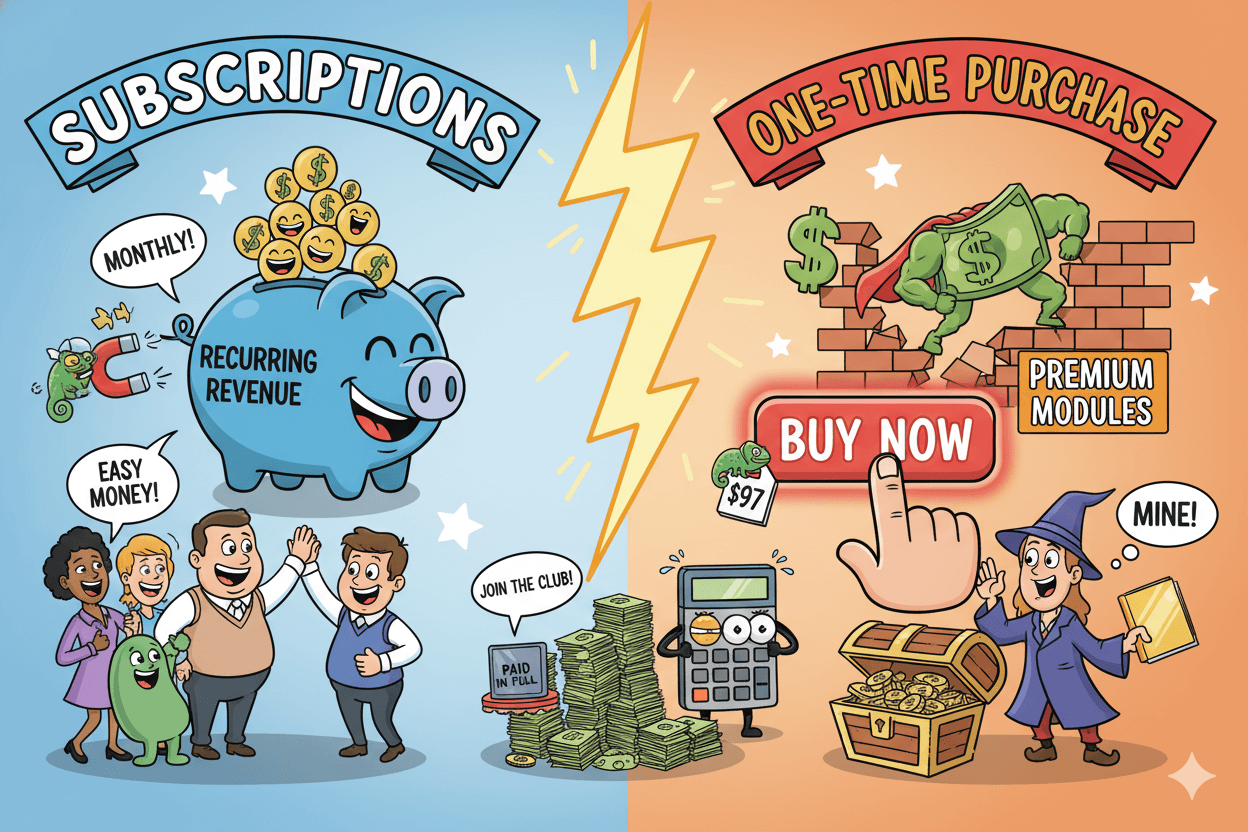
Access Controls and Level-Locked Content
Control access at two layers. First, course permissions: in Classroom, edit a course and choose who can view it—great for separating free lessons from premium content.
Second, level-locked courses: gate a course by level so members unlock it after earning points from likes on their posts and comments. This ties learning to participation and keeps momentum high.
You can also set event permissions so only all members, members at a certain level, or members in a specific course can attend.
Before you charge: connect payouts in Settings. Skool uses Stripe Express for creator payouts, which is distinct from a regular Stripe account.
The payouts article confirms the Express flow and weekly initiation cadence; Stripe’s docs explain what you can see in the Express dashboard.
Compliance note: Pricing models and payout details can change. Confirm on Skool’s live help pages before publishing or purchasing.
Engagement Engine That Keeps Members Active
Likes become points; points become levels; levels unlock rewards.
Momentum wins. Skool builds it with points, levels, and leaderboards that turn everyday posts into visible progress your members can feel.
You set the rewards. The system does the nudging. Pair it with smart event access and simple onboarding and the loop keeps turning.
Level-Locked Rewards
Skool lets you lock a course by level so members unlock it after earning enough points through community likes. The help guide confirms the mechanic and the 1-like-equals-1-point rule.
This ties learning to contribution and turns your best lessons into rewards that fuel more posting.
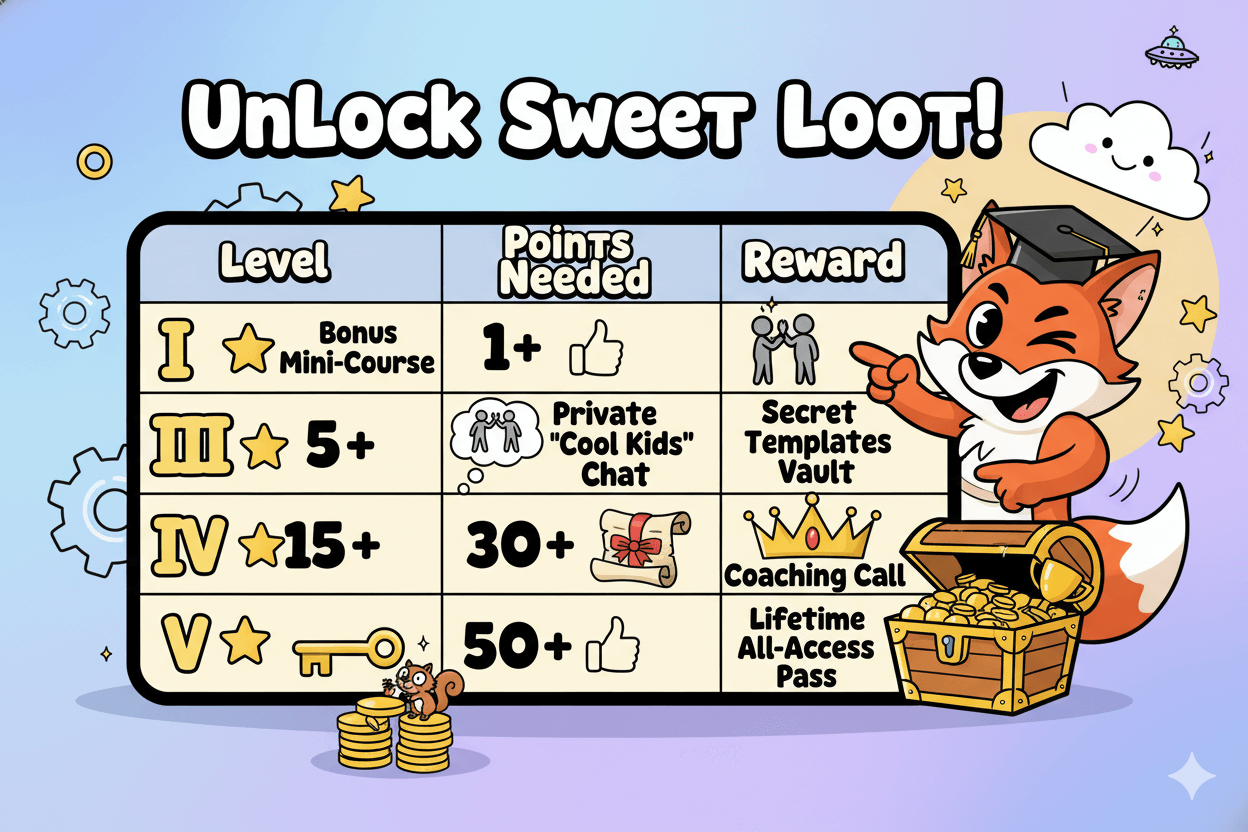
micro_challenge: Announce a 14-day sprint. Award a level-locked mini course at a reachable level and feature the top five on the leaderboard each Friday. It gives shy members a reason to post now.
Events and Access
Live sessions amplify the loop. For each event you can choose who may attend: all members, members at a specific level, or members who have access to a specific course.
This keeps premium calls valuable and gives clear milestones to reach before the next workshop or Q&A.
The Calendar category in Skool’s help center covers creating events, going live, and editing details. Use it to set a dependable cadence that members can plan around
…then layer level rules only where it sharpens focus. Consistency plus a small gate is often enough to raise attendance.
Onboarding That Sparks Posting
Good engagement starts at join. You can add up to three Membership Questions that applicants must answer before submitting.
Answers are visible to admins for approval and can be piped to a CRM with the Skool Zapier trigger “Answered Membership Questions.” Use one question to prompt a first post idea.
Course permissions add another simple control. Set who can view each course, then pair permissions with level locks to reward participation without manual granting. These two layers keep the system fair and predictable for new members.
Why it works: Visible progress plus unlockable rewards creates a feedback loop. Members post, earn likes, gain levels, and unlock new rooms or events. You design the milestones. Skool does the counting.
Monetization Pathways Beyond Subscriptions
Earn from sales and referrals—platform and member-level.
You can earn from two directions at once: your community sales and affiliates. Skool gives you a platform-wide affiliate program that pays you for referring Skool itself, plus a member-affiliates feature inside your own group on Pro.
Add light automation to send new-paid-member data to your CRM and your revenue stack compounds.
Member-Affiliates (Pro)
Turn your happiest members into a growth channel. In Settings → Admin → Affiliates, set your commission percent and enable referrals for that community.
Members get a personal link, see their referrals, and you control payouts. Skool’s help center is explicit that this feature is available on Pro, not Hobby.
When a paid group has member-affiliates turned on, each member sees the invite option and an affiliate dashboard that tracks who joined from their link.
Skool’s guide walks through the click-paths and notes the “how to refer and get paid” flow for members. Use this to reward advocacy and reduce ad spend.
pro_tip: Start with a simple, flat commission for 90 days. Announce it in a pinned post and a short Loom. Review referral lift monthly and adjust percent or perks based on real conversion. (Mechanics: enable in Affiliates tab, set %, publish rules.)
Skool Affiliate Program
This is separate from your community. Share your Skool affiliate link and you earn 40% of monthly recurring revenue for life on referred customers.
Skool also notes automatic attribution if someone creates a new group from inside your group, which can turn your community into a second income stream.
For clarity with readers: community member-affiliates pay commissions on your group’s memberships (you set the %).
The Skool Affiliate Program pays commissions on Skool’s subscriptions. Keep the two links distinct in your docs and dashboards so reporting stays clean.
Light CRM Automation
Close the loop with follow-ups you don’t have to remember. Skool’s Zapier Integration exposes triggers to send paid members’ name and email to your CRM and to capture membership-question answers for onboarding.
There are companion actions like inviting a member or unlocking a course, which you can chain into simple post-purchase journeys.
A practical starter flow: when a new paid member fires, create/update the contact in your CRM, tag them with the purchased tier, and schedule a welcome email sequence.
Skool’s “How to use Plugins” article calls out this use case and best practices for automating membership info.
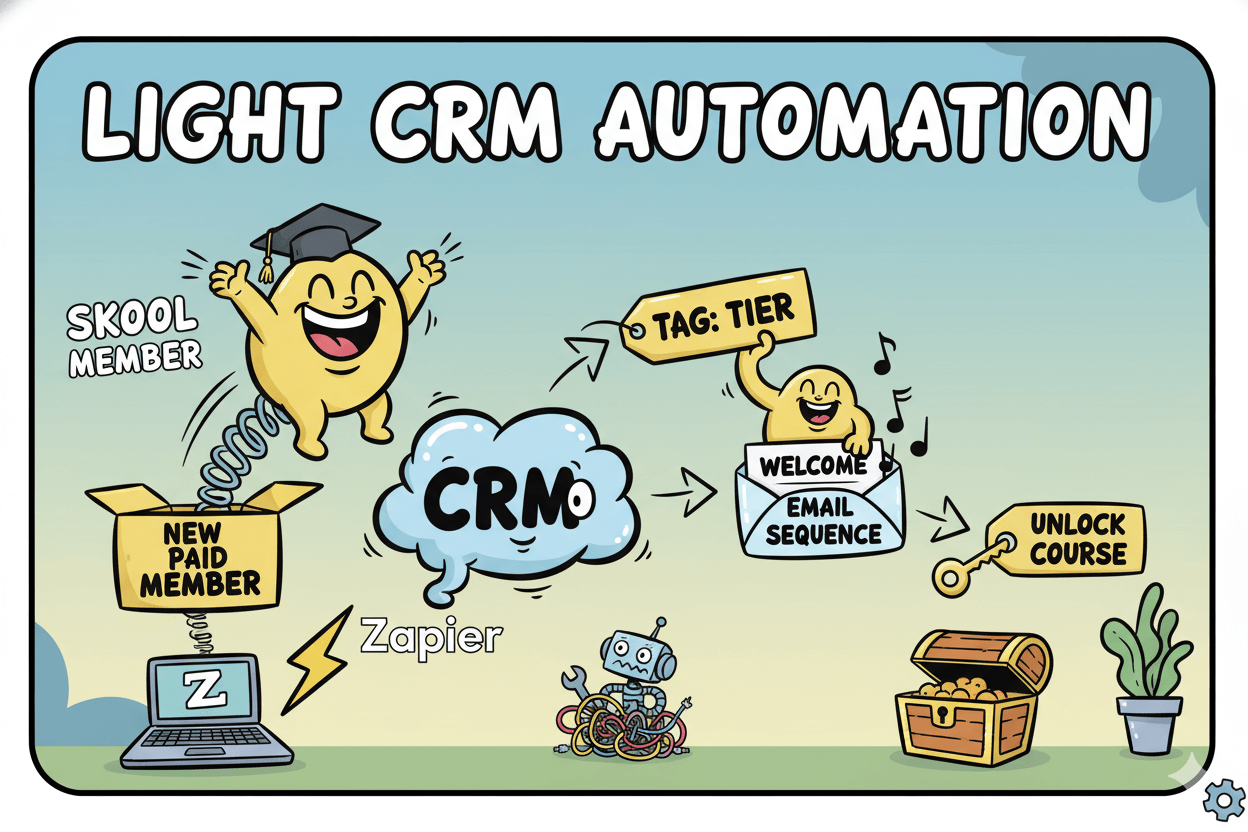
Disclaimer: Commission terms and plugin options can change. Confirm the current Affiliate Program page and Help Center setup guides before publishing your offer or documentation.
Who Skool Is Best For Today
Choose Skool when engagement beats customization.
Choose Skool when simple setup, visible progress, and clean payouts matter more than heavy customization.
Both plans include the core features—community, Classroom, Calendar—with unlimited members and courses; Pro adds unlimited admins and a lower baseline fee schedule that favors growth.
If you want engagement you can measure and reward, Skool fits.
Solo Creator or Coach
You need to launch quickly, prove demand, and keep the workflow light. Start on Hobby ($9/mo) to validate your offer with minimal overhead; upgrade to Pro when revenue or admin load grows.
Points and levels make your coaching container dynamic without extra tools, and event permissions let you gate premium calls by level or course access.
Many creator reviews highlight Skool’s low-friction setup for coaching cohorts and community-led courses.
Local Small Business
If you run workshops, memberships, or clubs, Skool gives you a clean loop: post → attend → level up → unlock.
Use Calendar for monthly sessions, Classroom for on-demand lessons, and level-locked courses as simple rewards that encourage participation between events.
Because likes translate to points and points raise levels, customers see their progress and return. This works well for fitness studios, tutoring groups, and community programs that benefit from steady engagement.
Small Teams Scaling
When you’re past validation, Pro compounds advantages: unlimited admins for moderator coverage, lower baseline transaction fees for healthier margins, and member-affiliates so fans can refer new buyers with a commission you set.
Add Auto Affiliate to capture platform referrals when someone spins up a new group from yours. Tie new paid-member events into your CRM with the Zapier trigger to keep onboarding tight.
This stack turns community momentum into predictable acquisition.
pro_tip: Publish a simple “Level 3 unlock” course as your first reward. It nudges posting early and gives your moderators a clear goal to coach toward.
Why this fit holds: unlimited members on both plans reduce growth friction; levels and leaderboards create visible progress that members enjoy; event and course permissions let you align access with contribution. As several fresh reviews note, Skool’s sweet spot is engagement-led communities where simplicity wins.
Quick-Start Checklist and 90-Day Plan
Ship a starter course and two events—then let levels do the rest.
Launch fast, then iterate. Pick a pricing model, connect payouts, publish one course, and schedule two events so members have reasons to show up.
Tie engagement to rewards with level-locked content and keep momentum with a simple cadence you can sustain.
Pre-Launch Setup
- Connect payouts. In Settings → Payouts, link your bank with Stripe Express. Skool clarifies that Express is distinct from a regular Stripe account and is used to send weekly payouts. First payout can take longer due to verification.
- Choose a pricing model. Skool supports Free, Freemium, Tiers, and 1-time purchases; preview the pricing page before you go live. Use Tiers when you want multiple paid plans at signup; use Freemium if you prefer free entry with upgrades later.
- Publish a starter course. In Classroom, create a short course that teaches one quick win. Confirm access with course permissions and plan one bonus module you can unlock later.
- Schedule two events. Add a kickoff call and a Q&A. Set attendance permissions by level or by course access to protect premium time.
do’s_and_don’ts:
Do connect payouts before setting prices. Do preview pricing/Tiers. Don’t overbuild; ship one course and two events first.
90-Day Engagement Cadence
Weeks 1–2: Give members two obvious actions—watch the starter course and attend the kickoff call. Remind them that 1 like = 1 point and points raise levels shown on the leaderboard.
Weeks 3–6: Announce a mini challenge. Gate a bonus course at a reachable level so posting and helpful replies unlock it. This makes progress visible and links learning to contribution.
Weeks 7–12: Maintain a steady rhythm—one workshop and one office-hours session per month—using event permissions to keep premium sessions focused.
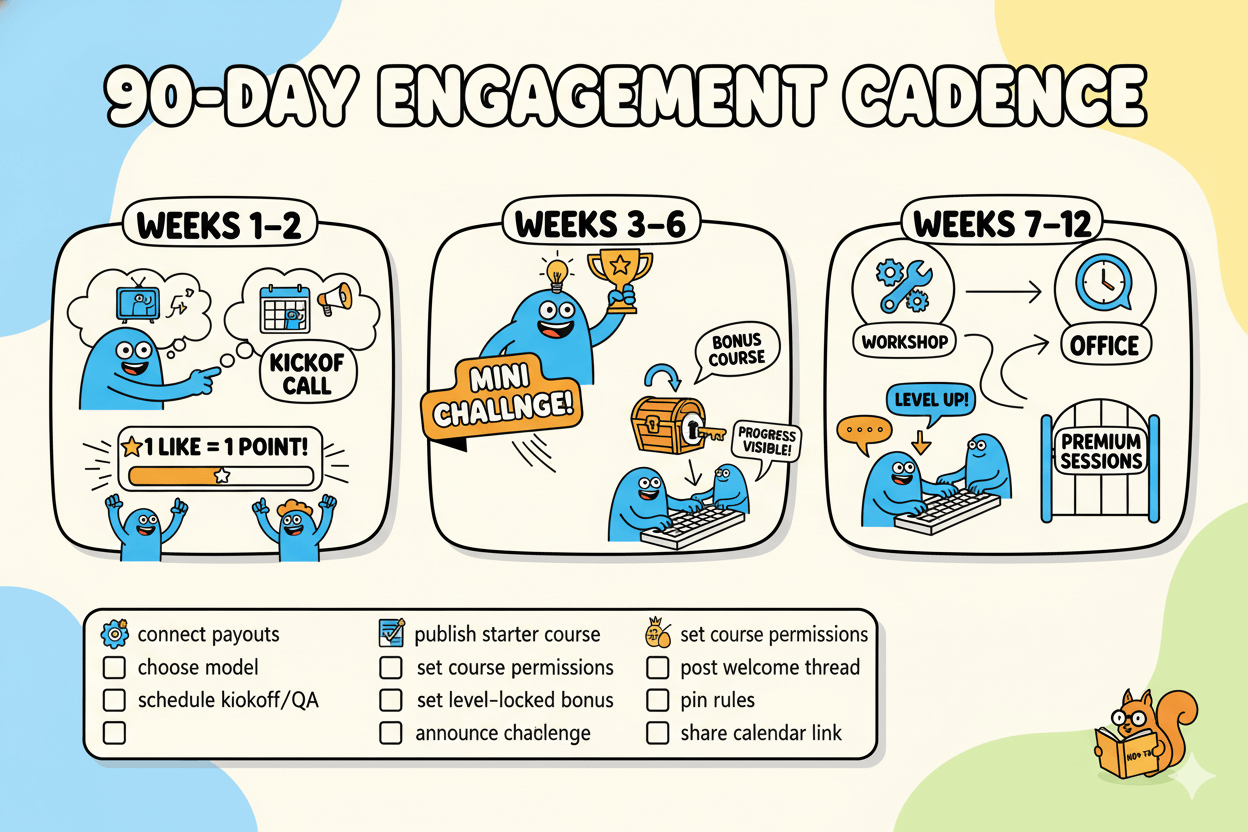
Metrics and Simple Iterations
Track three signals weekly: attendance (events), posts/comments per member, and level progression. If posting lags, lower the bonus course threshold or add a mid-level perk.
You can also grant access manually for support cases when a course is set to Level Unlock, Buy Now, or Private.
Note: pricing, fees, and payout timelines evolve. Recheck the live pricing and help articles before publishing or promoting your offer.
Conclusion
You now have the full picture. Skool gives you one home for community, courses, and events, then uses simple mechanics—1 like = 1 point, levels, and leaderboards—to keep people engaged and moving forward.
When you’re ready to charge, you connect payouts through Stripe Express, set your price, and go live. The Hobby plan keeps fixed cost tiny at $9/month.
The Pro plan supports scaling with lower per-transaction fees—2.9% + $0.30 up to $900, then 3.9% + $0.30 from $901+—so margins stay healthy as your ticket size rises.
Monetization is straightforward. You can sell subscriptions or enable one-time course purchases with a “Buy Now” price inside Classroom.
If you want extra lift, member-affiliates on Pro let your best customers refer others for a commission you set, and Skool also offers a platform-level affiliate path.
Both pair well with light automation, like sending new paid-member details to your CRM via Zapier.
The fit is clear. Choose Skool if you value fast setup, visible progress, and clean payouts over heavy customization. Start on Hobby to validate, then step into Pro when revenue or admin load grows.
Keep your flywheel simple: post → earn likes → level up → unlock content or events. That loop is the quiet engine behind durable communities.
Before you publish prices or projections, confirm the live Pricing and Payments FAQ pages, since numbers can change.
Then ship your first course, schedule two events, and turn on one level-locked reward. Small moves, repeated weekly, compound fast on Skool.

Skool: Points, Levels, and Offers That Convert




